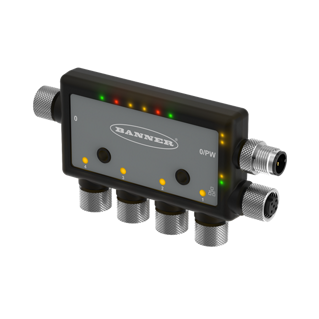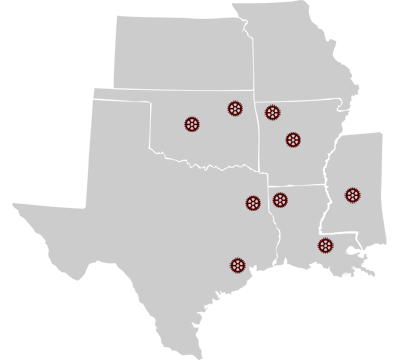The newest addition to Banner's Snap Signal product family, the compact and robust DXMR90 is a central hub for IIoT device monitoring.
It combines signals from connected machine sensors and outputs comprehensive data for:
- insight-driven OEE.
- system diagnostics.
- predictive maintenance.
- 24/7 cloud monitoring services.
As a central component of this portfolio, the DXMR90 houses a processor that receives signals from sensors and other connected devices, through four dedicated Modbus ports. It combines all of these signals into one unified stream of insightful device data, which can be exported out through industrial Ethernet protocols.
-
Converts Modbus RTU to Modbus TCP/IP, Ethernet I/P, or Profinet
-
Internal logic driven by action rules for easy programming, or MicroPython and ScriptBasic for developing more complex solutions

-
Internet protocols including RESTful, MQTT, and APIs
-
Compact housing saves space and weight compared to traditional “block”-style form factors
-
Email alerts can be set up directly from the DXMR90
-
Equipped with IP65, IP67, and IP68 rated housing for use in challenging environments
-
Powered by 12 to 30 V dc
-
RS-485 and Ethernet communications ports
-
User programmable LEDs for local status indication
-
Connects to databases (including Banner's Cloud Data Services) over Ethernet or through a cellular enabled DXM Controller
-
Ideal for IIoT data analytics, condition monitoring, predictive maintenance, OEE analysis, diagnostics, and troubleshooting
The DXMR90 harnesses the power of the Industrial Internet of Things by combining Modbus signals into 24/7 condition monitoring data from machines and automated processes. If the captured data identifies activity that falls outside of user-customizable performance thresholds, operators receive immediate notifications. Those specific issues can then be addressed before they result in critical part failures or other problems that could halt or interrupt production.
The DXMR90 features four female M12 ports, which can receive native Modbus signals and an ever-expanding variety of legacy electronic signal types converted to Modbus using other Snap Signal products. These ports can also connect to Banner radios to receive signals wirelessly—even at distances of up to six miles. Each port can be configured as its own Modbus Client, with selectable baud rate and parity settings, for a series of connected device signals. The DXMR90 also features an M12 D-coded Ethernet connection port for communicating over Modbus TCP, Ethernet/IP, and Profinet, or for controller configuration.
A further application for this technology is possible with networks such as Banner’s Cloud Data Services (CDS). Cloud computing allows manufacturers to harness the greater potential of IIoT for advanced data analytics. The combined signal from the DXMR90 can be sent directly to the cloud, where data is processed in real-time and presented as useful performance metrics. Beyond providing manufacturers with the cost-savings advantage of in-house monitoring, this approach also allows for comprehensive predictive maintenance. Banner’s Cloud Data Services provide a web-based platform for accessing, storing, protecting, and exporting critical data from industrial system devices. Users can customize how cloud data is displayed in their online applications, for personalized graphical presentations of in-depth, up-to-the-minute insight of all monitored machine parameters. The cloud can also send email notifications of any unexpected deviations from established baselines. Alternatively, the DXMR90 can be connected to a DXM1200 Wireless Controller to send data to CDS or other cloud servers.
APPLICATIONS
- Condition monitoring
- Predictive maintenance
- OEE analysis and tracking
- Lean manufacturing
- Data collection and performance metrics
- Diagnostics and troubleshooting


